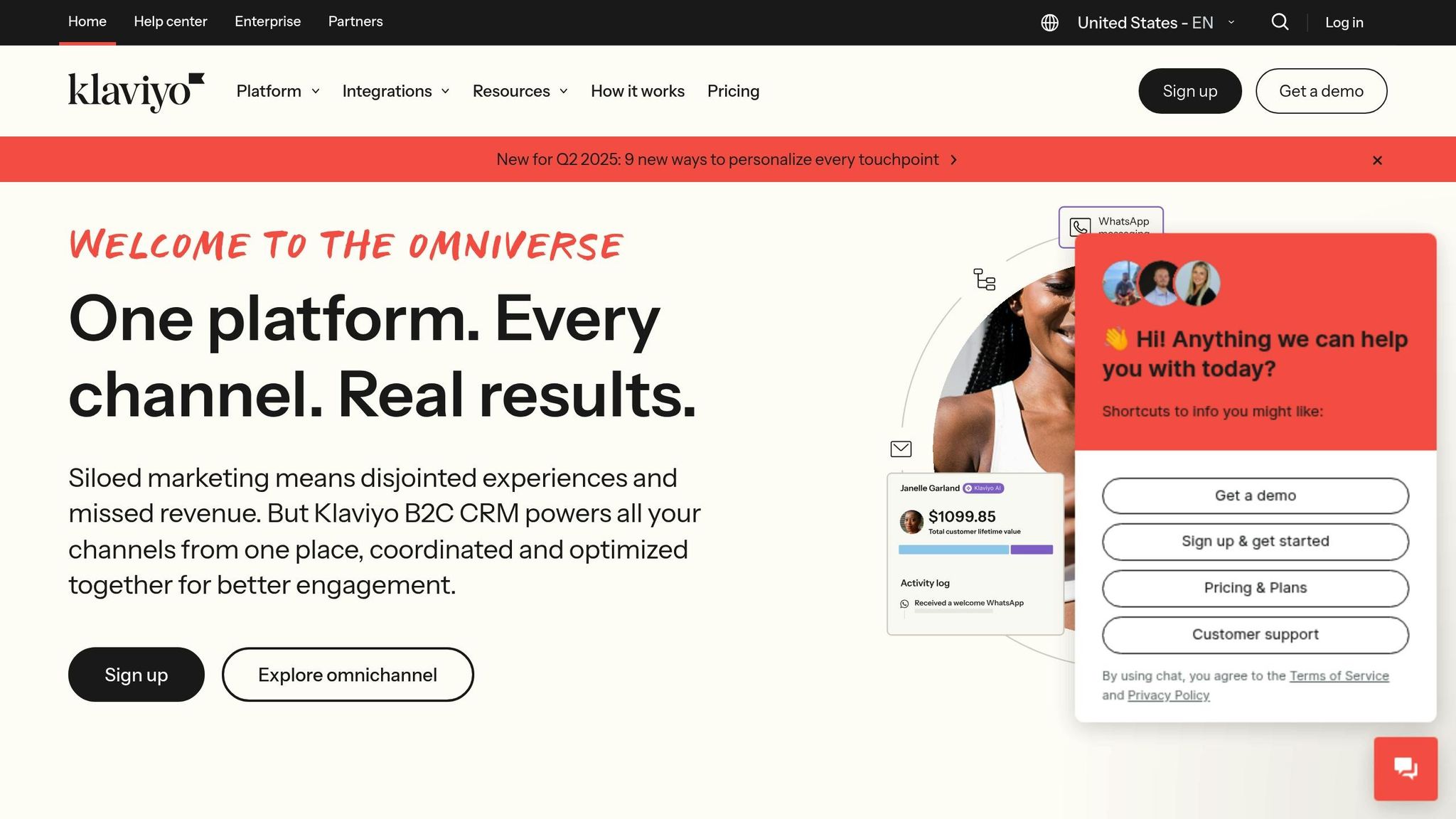Choosing between Mailchimp and Klaviyo comes down to your business type and growth goals. Mailchimp is ideal for small businesses seeking simplicity and multi-channel marketing tools, while Klaviyo caters to eCommerce brands needing advanced automation, segmentation, and revenue tracking.
Key Takeaways:
- Mailchimp: Affordable for small lists, beginner-friendly, and offers a broad range of marketing tools (email, SMS, ads, social posts, and more). Pricing starts at $13/month for 500 contacts but scales to $310/month for 30,000 contacts.
- Klaviyo: Designed for eCommerce with features like AI-driven segmentation, real-time data syncing, and predictive analytics. Pricing starts at $20/month for 500 contacts, reaching $500/month for 30,000 contacts.
Quick Comparison:
| Feature | Mailchimp | Klaviyo |
|---|---|---|
| Target Audience | Small businesses, general use | eCommerce brands, D2C companies |
| Pricing (500 Contacts) | $13/month (Essentials Plan) | $20/month (Email Plan) |
| Scalability (30,000 Contacts) | $310/month | $500/month |
| Core Strength | Multi-channel marketing tools | Advanced eCommerce automation |
| Ecommerce Focus | Basic tools | Advanced segmentation & analytics |
If you're running an eCommerce business focused on scaling and maximizing revenue, Klaviyo's higher cost can pay off with its robust features. For simpler marketing needs, Mailchimp offers a cost-effective, all-in-one solution. Both platforms provide free trials, so testing them can help you decide which aligns better with your goals.
Klaviyo vs Mailchimp for eCommerce email marketing PT 1 | Magnet Monster | Retention Marketing

Feature Comparison
When choosing an email marketing platform, the strength and versatility of its core features can make all the difference. Both Mailchimp and Klaviyo deliver powerful tools for segmentation, analytics, and multi-channel marketing, though their methods and focus areas differ.
Automation and Segmentation Tools
Segmented campaigns have been shown to boost revenue by an impressive 760%, making segmentation a critical feature for businesses aiming for sustained growth.
Mailchimp provides predictive segmentation, helping users identify customers who are likely to make repeat purchases. It also includes pre-built segments for common targeting needs. With its advanced segment builder (available on Standard plans and above), users can create detailed segments based on multiple conditions, such as email or SMS activity.
"Our most effective campaigns came from using Mailchimp's existing segmentation where we used the Mailchimp API to tag our customers based on their engagement and whether they paid us. We rely on that a lot when we do marketing and that's where we saw a really, really nice conversion, which was super helpful." - Snigdha Sur, Founder & CEO of The Juggernaut
On the other hand, Klaviyo takes a more AI-driven approach with its Segments AI feature. Users can simply describe the type of customers they want to target, and the platform automatically creates the segment. Both platforms utilize behavioral data - like website activity, app usage, and campaign interactions - to build these segments. This is particularly important, as 91% of consumers prefer shopping with brands that recognize them and provide tailored offers.
These advanced segmentation tools lay the groundwork for more targeted and effective analytics.
Analytics and Reporting Features
Mailchimp and Klaviyo take distinct approaches to analytics, catering to different business needs.
Klaviyo’s analytics are deeply tied to eCommerce performance. The platform tracks conversions, revenue, and customer engagement across emails, offering predictive insights like future spending, churn risk, and next order dates. Users can also build custom reports, set alerts for account issues, and compare their performance against industry benchmarks using market data.
Mailchimp, by contrast, focuses on campaign-level insights. Its reports cover metrics such as open rates, clicks, bounces, unsubscribes, and overall engagement. While many advanced reporting features are locked behind higher-tier plans, Mailchimp's integration with Google Analytics expands its capabilities, offering access to over 50 detailed reports.
"We wanted a full overview of the customer, but that wasn't available in Mailchimp at all." - Sandip Chaudhuri, VP of product marketing, Parts Avatar
For businesses looking to track long-term ROI, Klaviyo’s revenue-focused analytics provide clearer insight into how email marketing impacts profitability.
Beyond analytics, the ability to connect with customers across multiple channels is another key factor to consider.
Multi-Channel Marketing Support
The multi-channel capabilities of Mailchimp and Klaviyo reflect their unique strengths. Mailchimp offers a broad suite of marketing tools, including email, SMS, landing pages, ads, social posts, and surveys. This makes it a great choice for businesses seeking a comprehensive, all-in-one marketing platform.
Klaviyo, however, stands out for its seamless integration of email and SMS marketing. Its unified customer profiles capture behavior across both channels, enabling highly personalized campaigns.
| Feature | Klaviyo | Mailchimp |
|---|---|---|
| SMS Marketing Coverage | Available in 21 countries | Available in the US only |
| Extra Marketing Channels | Email, SMS | Email, SMS, landing pages, ads, social posts, surveys |
| eCommerce Specialization | Product feeds, predicted CLV, custom recommendations, revenue per email | Basic abandoned cart emails, product recommendations (if integrated) |
| App Integrations | 300+ (eCommerce-focused) | 330+ (broader business tools) |
For eCommerce brands, Klaviyo’s specialized approach is particularly appealing. Many online stores generate as much as 35% of their revenue from email marketing, and Klaviyo’s focus on smarter segmentation, cross-channel flows, and data centralization positions it as a strong choice for businesses looking to scale internationally.
"With smarter segmentation, cross-channel flows, and data consolidation, Klaviyo is built to drive more growth for ecommerce brands." - Klaviyo
When it comes to integrations, Klaviyo connects with over 300 apps tailored to eCommerce needs. Meanwhile, Mailchimp offers a slightly broader range, with over 330 integrations spanning various business tools.
Pricing and Scalability Analysis
When choosing an email marketing platform, two factors stand out: cost and scalability. Mailchimp and Klaviyo take different approaches to pricing, which can have a big impact on your budget as your business grows.
Pricing Structure Comparison
Mailchimp and Klaviyo's pricing models cater to different needs, and understanding these differences is key to making the right choice.
Mailchimp offers a tiered pricing structure with four main plans:
- Free: Includes up to 500 contacts and 1,000 monthly email sends.
- Essentials: Starts at $13/month for up to 500 contacts.
- Standard: Starts at $20/month for 500 contacts.
- Premium: Starts at $350/month for 500 contacts.
Klaviyo, on the other hand, uses a usage-based pricing model:
- Free: Covers up to 250 contacts and 500 monthly email sends.
- Email Plan: Starts at $20/month for 500 contacts.
- Email & SMS Plan: Starts at $35/month for 500 contacts.
- Marketing Analytics Add-On: Costs an additional $100/month for up to 500 contacts.
Mailchimp's advanced features are often locked behind higher-tier plans, while Klaviyo includes these features as part of its standard offerings.
"Klaviyo and Mailchimp seem to keep their entry-level pricing at parity: for 500 contacts, you'll pay around $20/month for comparable email marketing plans on both platforms. If you're looking at free plans or high-volume plans, though, you'll find bigger differences."
– Ryan Kane
"Mailchimp also lets you scale up more gradually from the free plan. Mailchimp's Essentials plan, at $13/month for 500 contacts and $25/month for 1,500 contacts, is a great choice for small businesses who have outgrown the free plan but still aren't ready to pay big bucks for more analytics and eCommerce automations than they need."
– Ryan Kane
As your subscriber count grows, these differences become more pronounced.
Growth and Scaling Capabilities
The pricing gap between Mailchimp and Klaviyo widens as your contact list expands, making scalability a critical consideration.
| Contact Count | Klaviyo | Mailchimp | Price Difference |
|---|---|---|---|
| 500 | $20/month | $13/month (Essentials) | +$7 |
| 10,000 | ~$150/month | ~$100/month (Standard) | +$50 |
| 15,000 | $350/month | $200/month | +$150 |
| 30,000 | $500/month | $310/month | +$190 |
Mailchimp charges for duplicate contacts across different audiences, which can inflate costs. Klaviyo, however, charges once per contact, no matter how many segments they belong to.
For businesses with large eCommerce operations, these platforms cater to different needs. Mailchimp can handle larger lists but may feel cumbersome for enterprise-level eCommerce. Klaviyo, with its linear pricing model, offers better predictability, even if the costs are generally higher.
Long-Term ROI Analysis
The pricing models of these platforms don't just affect scalability - they also shape your long-term ROI. While Klaviyo is often more expensive, its focus on driving revenue can make it a worthwhile investment for eCommerce businesses.
Across all platforms, email marketing ROI averages $42 for every dollar spent. Klaviyo users, however, report even higher returns - earning $85 on Shopify stores for every $1 spent on email marketing.
User results highlight the revenue potential. Klaviyo users often attribute 20-30% of their revenue to email marketing flows. For example, one client saw a tenfold increase in recovered revenue after switching to Klaviyo's abandoned cart flow. Another retailer used Klaviyo's segmentation tools to achieve a 4x higher conversion rate compared to standard product announcements.
Mailchimp's lower costs and gradual scaling options are appealing for businesses with basic email marketing needs. However, for eCommerce brands requiring advanced features, Mailchimp's limitations at lower tiers often necessitate costly upgrades to Premium plans.
Ultimately, your choice will depend on your business model and growth goals. Klaviyo's higher costs can be justified by its advanced automation, analytics, and revenue-tracking capabilities, which are designed to drive sales. For businesses with simpler needs, Mailchimp's affordability and flexibility may offer better value.
For more insights and comparisons of email marketing platforms, the Email Service Business Directory (https://emailservicebusiness.com) is a helpful resource for exploring additional options.
Integration and Platform Connections
The ability of an email platform to integrate with various business tools plays a critical role in ensuring long-term efficiency and scalability. Both Mailchimp and Klaviyo offer a wide range of integration options, but their approaches differ, which can affect how well they fit into your existing tech setup.
E-commerce Platform Connections
Klaviyo offers native integrations with platforms like Shopify, BigCommerce, WooCommerce, Magento, and Salesforce Commerce Cloud. This setup allows for real-time syncing of customer data, making it a strong choice for businesses relying on these platforms. Mailchimp, on the other hand, integrates with WooCommerce, BigCommerce, Squarespace, Stripe, QuickBooks, and Salesforce. However, its Shopify integration now requires third-party tools to function.
Klaviyo’s Shopify integration stands out by syncing customer profiles, order history, product catalogs, and behavioral data in real time. This enables highly targeted and personalized campaigns. Mailchimp, while capable of syncing basic information like purchase history and cart activity, focuses its WooCommerce integration primarily on customer data and purchase history. This limits its ability to offer detailed segmentation and advanced automation. Additionally, Klaviyo updates data in real time, whereas Mailchimp may encounter slight delays in synchronization. These dynamic e-commerce connections make Klaviyo particularly appealing for businesses aiming for global growth.
Business Tool Integration Options
Both platforms boast hundreds of native integrations with e-commerce apps and CRM tools. They also work with Zapier, opening the door to thousands of additional tools. Mailchimp provides a dedicated integration marketplace, while Klaviyo lists its options directly on its website.
Klaviyo’s integrations are built to enrich data and enable more advanced audience targeting. Mailchimp, in contrast, covers a broader range of categories - spanning e-commerce, CRM, accounting, surveys, and social media - though it lacks the depth of data enhancement that Klaviyo offers. Beyond integrations, both platforms include features that support businesses looking to expand their reach globally.
Global Features and Multi-Language Support
For companies operating in international markets, precise language support can be a game changer. Klaviyo excels in this area, offering robust tools for segmenting audiences by language. This makes it easier to deliver targeted email campaigns in multiple languages. Its seamless Shopify integration further enhances multilingual strategies by syncing data efficiently and tailoring emails based on customer behavior. Klaviyo also handles complex automation logic - such as creating region-specific or language-specific welcome series - more effectively than Mailchimp.
Mailchimp does provide multi-language email campaign support, but Klaviyo’s advanced features make it a better option for businesses seeking international scalability.
"When it comes to managing multilingual email marketing campaigns, Klaviyo is the better option, especially for Shopify." - Erlan from Growave
sbb-itb-6e7333f
Platform Development and Updates
Long-term success often hinges on how well a platform adapts over time. Both Mailchimp and Klaviyo take different approaches to innovation, tailoring their updates to meet shifting market demands.
AI and Predictive Tools
Klaviyo stands out by blending a built-in customer data engine with AI-driven features, delivering advanced automation and personalization. Its platform includes tools like dynamic product recommendations, predictive analytics, and automated content creation - all available across its paid plans. These features are designed to drive revenue, and the results speak for themselves. For example, Svenfish credits 82% of its year-to-date revenue to Klaviyo's capabilities, while Garrett Popcorn saw a fourfold increase in revenue per recipient.
"We're making Klaviyo our central CRM… It's easy to use, it's modern, and simplifies processes with AI. You don't want to waste time, especially at a small business like Svenfish, where we're all wearing multiple hats. Klaviyo makes life easier." - Sreevats R., product manager at Svenfish
Mailchimp, on the other hand, leverages tools like its Creative Assistant, send-time optimization, and audience segmentation to enhance email marketing efforts. Impressively, its AI features are even included in the free plan, with paid upgrades starting at $20/month. Recently, Mailchimp users sent over 3.1 billion emails using its Inline AI Assistant, with AI-powered send-time optimization achieving up to 25% higher open rates and 15% more conversions.
These AI advancements highlight the ongoing evolution of both platforms, as they continue refining their offerings to meet user needs.
Feature Updates and Development Speed
Klaviyo focuses heavily on e-commerce, rolling out updates that enhance automation, data analysis, and multi-channel marketing. This specialized approach allows it to adapt quickly to the needs of retail and online businesses.
Mailchimp, by contrast, takes a broader approach to serve a wide variety of business types. While this versatility is beneficial, it can sometimes lead to slower development of e-commerce-specific tools compared to Klaviyo. Both platforms are influenced by trends like stricter data privacy requirements, the consolidation of multi-channel marketing, and the increasing role of AI in personalization. As David Visser, CEO of Zyber, observes:
"Generative AI - especially Klaviyo AI - allows marketers to focus on things that drive the highest ROI without compromising on quality."
These development strategies reflect the distinct priorities of each platform, shaping their feature sets to align with different business needs.
User Experience and Support Quality
The user experience offered by Klaviyo and Mailchimp differs significantly. Mailchimp provides an intuitive dashboard with straightforward navigation, including a prominent "Create" button that simplifies campaign setup. Klaviyo, while offering advanced functionality, may require more clicks to access certain features, making it better suited for users familiar with its tools.
Customer support also varies between the two. Klaviyo typically responds within about two hours, whereas Mailchimp averages around five hours. Support for free users is limited - Klaviyo offers email and chat support for 60 days, while Mailchimp provides 30 days of email support. User reviews frequently praise Klaviyo for smooth migrations and strong ROI, while Mailchimp users have occasionally reported frustrations with account suspensions and pricing changes.
These differences in user experience and support quality further highlight how each platform caters to distinct types of businesses and operational needs.
Platform Selection Guide
Choose Mailchimp if you're looking for simplicity and an all-in-one solution for small business marketing. Opt for Klaviyo if your focus is on advanced e-commerce automation.
Key Differences Summary
The main difference between these two platforms lies in their audience and features. Mailchimp is designed for beginners and small businesses seeking a user-friendly marketing tool. On the other hand, Klaviyo caters to e-commerce brands that need advanced automation and detailed customer insights.
| Feature | Klaviyo | Mailchimp |
|---|---|---|
| Target Audience | E-commerce brands, D2C companies | Small businesses, beginners, general marketing |
| Pricing Structure | About $20/month for 500 contacts; $350/month for 15,000 contacts | Around $13/month for 500 contacts; $200/month for 15,000 contacts |
| Learning Curve | Steeper learning curve with complex features | Beginner-friendly design |
| Marketing Channels | Focus on email and SMS | Email, SMS, landing pages, ads, social posts, surveys |
| E-commerce Features | Advanced automation, real-time segmentation, revenue tracking | Basic e-commerce tools for smaller shops |
While Klaviyo may cost more at scale, it offers all its features regardless of contact count. Mailchimp, however, adjusts pricing based on feature usage. For Shopify stores, Klaviyo's predictive analytics can generate up to $85 for every $1 spent, while Mailchimp simplifies campaign creation with AI tools.
These differences make it easier to recommend the right platform based on your specific business needs.
Business-Specific Recommendations
Here are some tailored suggestions based on the type of business you run:
-
For Advanced Automation Needs: Klaviyo offers exceptional long-term value for businesses aiming to scale. Big names like Unilever, Glossier, and Mattel rely on Klaviyo for its real-time customer data integration, advanced segmentation, and revenue-focused analytics. As Chase Dimond from Boundless Labs explains:
"Klaviyo is [great] for people who don't care about paying a little bit more or who want to scale."
- For Simplicity and Versatility: Mailchimp is a go-to choice for traditional businesses, freelancers, bloggers, nonprofits, and niche agencies. Its multi-channel marketing capabilities - like website building, CRM tools, and social media management - make it ideal for those just starting out.
Both platforms offer free trials, so testing them with your actual data can help you decide which one aligns better with your workflow and growth plans. For further guidance, the Email Service Business Directory provides additional insights to support your email marketing journey.
FAQs
How does Klaviyo's AI-powered segmentation provide better results for eCommerce businesses compared to Mailchimp's tools?
Klaviyo’s AI-driven segmentation tools empower eCommerce businesses to craft campaigns that feel personal and relevant. By analyzing customer behaviors - like purchase history or abandoned carts - Klaviyo helps businesses automate targeted interactions and send messages that truly connect with specific groups of customers.
While Mailchimp provides more straightforward segmentation options, Klaviyo takes it a step further by tapping into a wealth of data points to create detailed customer profiles. This approach translates to stronger engagement, better conversion rates, and ultimately, higher revenue. For businesses aiming to thrive in the competitive eCommerce world, Klaviyo stands out as a powerful ally for long-term growth.
What should small businesses consider when choosing between Mailchimp and Klaviyo for long-term email marketing?
When choosing between Mailchimp and Klaviyo, small businesses should weigh a few critical factors: growth potential, automation capabilities, and pricing.
Klaviyo stands out for businesses focused on scaling up, offering advanced analytics and smooth ecommerce integrations. Its powerful tools are designed to support businesses aiming for long-term growth and more complex marketing strategies.
Meanwhile, Mailchimp is a more cost-effective option for those just starting out. Its user-friendly interface makes it a great pick for businesses with simpler needs or limited budgets. Consider your company’s growth ambitions, the complexity of your marketing efforts, and your financial resources to decide which platform fits your objectives best.
Which platform, Mailchimp or Klaviyo, offers better integration for businesses using Shopify or WooCommerce?
Integration Capabilities: Mailchimp vs. Klaviyo
When it comes to integrations, the choice between Mailchimp and Klaviyo often depends on the complexity of your business needs.
Klaviyo stands out with its real-time integrations with platforms like Shopify and WooCommerce. It offers advanced automation features, detailed customer insights, and smooth data synchronization. These tools are particularly helpful for e-commerce businesses looking to fine-tune their marketing strategies with precision.
Mailchimp, on the other hand, provides more straightforward integrations with these platforms. Its focus is on basic data syncing and campaign management, making it a solid choice for smaller e-commerce businesses or those with simpler operational requirements.
To sum it up, Klaviyo caters to businesses that need advanced automation and analytics, while Mailchimp is a better fit for those prioritizing simplicity and ease of use.


